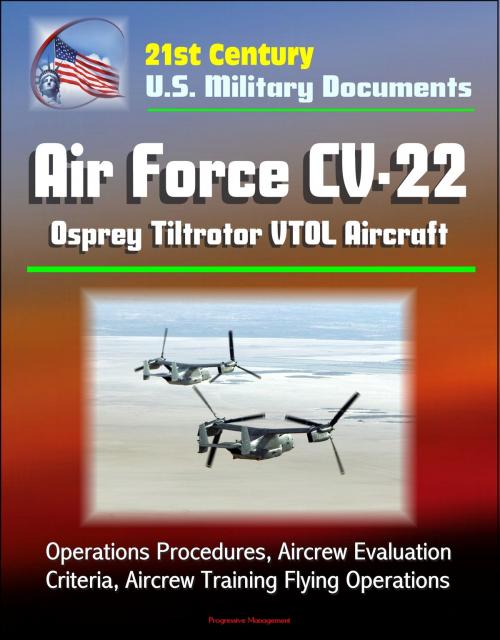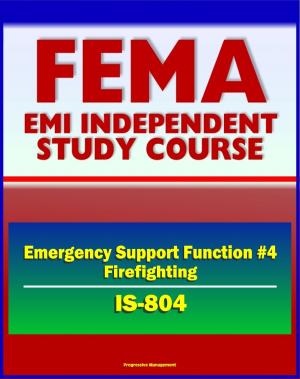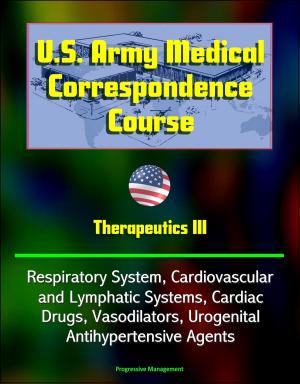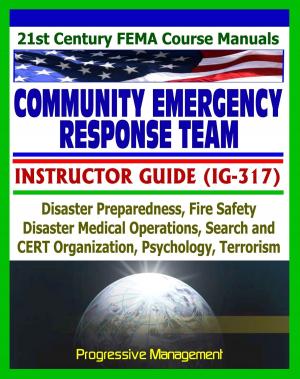21st Century U.S. Military Documents: Air Force CV-22 Osprey Tiltrotor VTOL Aircraft - Operations Procedures, Aircrew Evaluation Criteria, Aircrew Training Flying Operations
Nonfiction, Science & Nature, Technology, Aeronautics & Astronautics, History, Military, Aviation| Author: | Progressive Management | ISBN: | 9781310565892 |
| Publisher: | Progressive Management | Publication: | October 30, 2013 |
| Imprint: | Smashwords Edition | Language: | English |
| Author: | Progressive Management |
| ISBN: | 9781310565892 |
| Publisher: | Progressive Management |
| Publication: | October 30, 2013 |
| Imprint: | Smashwords Edition |
| Language: | English |
Three Air Force documents provide unique information about USAF operations of this aircraft.
Contents: Cv-22 Operations Procedures * CV-22 Aircrew Evaluation Criteria * CV-22 Aircrew Training
Chapter 1 * GENERAL INFORMATION * 1.1. General * 1.2. Applicability * 1.3. Key Definitions * 1.4. Deviations and Waivers * 1.5. Supplements * 1.6. Requisitioning Procedures * 1.7. Revisions * 1.8. Distribution * 1.9. Development of New Equipment and Procedures * Chapter 2 * COMMAND AND CONTROL (C2) * 2.1. General * 2.2. Command and Control * 2.3. Air Force Special Operations Command Forces OPCON * 2.4. Mission Monitoring * 2.5. Search and Rescue Satellite-Aided Tracking (SARSAT) * 2.6. Designation of a COMAFSOF * 2.7. Aircraft Commander Responsibility and Authority * 2.8. Mission Commander * 2.9. Air Mission Commander (AMC) * 2.10. Flight Lead * 2.11. Mission Clearance Decision * 2.12. Civilian Law Enforcement Support * Chapter 3 * CREW COMPLEMENT AND MANAGEMENT * 3.1. Aircrew Qualification * 3.2. Crew Complement * 3.3. Interfly * 3.4. Intrafly * 3.5. Scheduling Restrictions * 3.6. Maximum Flight Duty Period (FDP) * 3.7. Crew Rest * 3.8. Standby Duty * 3.9. Alert Duty * 3.10. Alert Procedures * Chapter 4 * COMMAND OPERATING GUIDELINES * 4.1. General * 4.2. Responsibility * 4.3. Avionics Cooling and Environmental Control System * 4.4. Electrical Systems * 4.5. Fuel Systems * 4.6. Landing Gear * 4.7. Navigation Systems * 4.8. Cockpit Displays * Chapter 5 * AIRCRAFT SECURITY * 5.1. General * 5.2. Security * 5.3. Procedures * 5.4. Arming of Crew members * 5.5. General Hijacking Guidance * 5.6. Aircraft Force Protection Risk Assessment Matrix * Chapter 6 * MISSION PREPARATION * 6.1. Flight Planning Systems * 6.2. Coordinates * 6.3. Flight Logs * 6.4. Mission Kits * 6.5. Weather Planning * 6.6. Wind Limits * 6.7. Illumination and NVG Requirements * 6.8. Adverse Weather Planning * 6.9. Fuel Planning * 6.10. En Route Planning. * 6.11. Aeronautical Chart Preparation * 6.12. Pre-mission Briefing Requirements * 6.13. Flight Crew Information File (FCIF) * 6.14. Flight Plans * 6.15. International Procedures * 6.16. Transoceanic/Remote area Procedures * Chapter 7 * GENERAL OPERATING PROCEDURES * 7.1. Low-level Operations * 7.2. Master Low-level Hazards Map * 7.3. Landing Zones/Helicopter Landing Zone Survey Requirements * 7.4. Life Support Requirements * 7.5. Flying Clothing/Safety Equipment * 7.6. Weight and Balance * 7.7. AFTO IMT 781, ARMS Aircrew/Mission Flight Data Document * 7.8. Preflight Inspections * 7.9. Tool Kits * 7.10. Checklist * 7.11. Flight Briefings and Procedures * 7.12. Controls * 7.13. Crew Duties and Responsibilities * 7.14. Communications Policy * 7.15. Aircraft Lighting * 7.16. Aircraft Taxi Obstruction Clearance Criteria * 7.17. Taxiway and Runway Width Requirements * 7.18. Arresting Cables * 7.19. Proprotor Turning Off-load and Onload Procedures * 7.20. Altitude Restrictions * 7.21. Oxygen Requirements * 7.22. IFF/SIF * 7.23. Traffic Collision Avoidance System TCAS Operations * 7.24. Electronic Devices * 7.25. Jamming and Interference * 7.26. Aircraft Servicing and Ground Operations * 7.27. Forced or Precautionary Landings * 7.28. En route Navigation and Instrument Approach Minimums * 7.29. Radar Altimeter Procedures * 7.30. Radar Advisories * 7.31. Advisory Calls * 7.32. Power Checks * 7.33. Passenger Policy * 7.34. Passengers Occupying Crew Positions * 7.35. Personnel Restraints * 7.36. Customs, Immigration, and Agriculture Inspections * 7.37. Utilization of Civilian Law Enforcement or Medical Personnel * 7.38. Crew Debriefing * 7.39. Hazardous Material Procedures * 7.40. Hazardous Medical Equipment: * Chapter 8 * FLYING TRAINING POLICY * 8.1. General * 8.2. Training Aircraft Not Capable of Flight * 8.3. Emergency Procedures * 8.4. IMC Terrain Following (TF)/Terrain Avoidance (TA) Training * 8.5. Power Required for Terminal Operations Training
Three Air Force documents provide unique information about USAF operations of this aircraft.
Contents: Cv-22 Operations Procedures * CV-22 Aircrew Evaluation Criteria * CV-22 Aircrew Training
Chapter 1 * GENERAL INFORMATION * 1.1. General * 1.2. Applicability * 1.3. Key Definitions * 1.4. Deviations and Waivers * 1.5. Supplements * 1.6. Requisitioning Procedures * 1.7. Revisions * 1.8. Distribution * 1.9. Development of New Equipment and Procedures * Chapter 2 * COMMAND AND CONTROL (C2) * 2.1. General * 2.2. Command and Control * 2.3. Air Force Special Operations Command Forces OPCON * 2.4. Mission Monitoring * 2.5. Search and Rescue Satellite-Aided Tracking (SARSAT) * 2.6. Designation of a COMAFSOF * 2.7. Aircraft Commander Responsibility and Authority * 2.8. Mission Commander * 2.9. Air Mission Commander (AMC) * 2.10. Flight Lead * 2.11. Mission Clearance Decision * 2.12. Civilian Law Enforcement Support * Chapter 3 * CREW COMPLEMENT AND MANAGEMENT * 3.1. Aircrew Qualification * 3.2. Crew Complement * 3.3. Interfly * 3.4. Intrafly * 3.5. Scheduling Restrictions * 3.6. Maximum Flight Duty Period (FDP) * 3.7. Crew Rest * 3.8. Standby Duty * 3.9. Alert Duty * 3.10. Alert Procedures * Chapter 4 * COMMAND OPERATING GUIDELINES * 4.1. General * 4.2. Responsibility * 4.3. Avionics Cooling and Environmental Control System * 4.4. Electrical Systems * 4.5. Fuel Systems * 4.6. Landing Gear * 4.7. Navigation Systems * 4.8. Cockpit Displays * Chapter 5 * AIRCRAFT SECURITY * 5.1. General * 5.2. Security * 5.3. Procedures * 5.4. Arming of Crew members * 5.5. General Hijacking Guidance * 5.6. Aircraft Force Protection Risk Assessment Matrix * Chapter 6 * MISSION PREPARATION * 6.1. Flight Planning Systems * 6.2. Coordinates * 6.3. Flight Logs * 6.4. Mission Kits * 6.5. Weather Planning * 6.6. Wind Limits * 6.7. Illumination and NVG Requirements * 6.8. Adverse Weather Planning * 6.9. Fuel Planning * 6.10. En Route Planning. * 6.11. Aeronautical Chart Preparation * 6.12. Pre-mission Briefing Requirements * 6.13. Flight Crew Information File (FCIF) * 6.14. Flight Plans * 6.15. International Procedures * 6.16. Transoceanic/Remote area Procedures * Chapter 7 * GENERAL OPERATING PROCEDURES * 7.1. Low-level Operations * 7.2. Master Low-level Hazards Map * 7.3. Landing Zones/Helicopter Landing Zone Survey Requirements * 7.4. Life Support Requirements * 7.5. Flying Clothing/Safety Equipment * 7.6. Weight and Balance * 7.7. AFTO IMT 781, ARMS Aircrew/Mission Flight Data Document * 7.8. Preflight Inspections * 7.9. Tool Kits * 7.10. Checklist * 7.11. Flight Briefings and Procedures * 7.12. Controls * 7.13. Crew Duties and Responsibilities * 7.14. Communications Policy * 7.15. Aircraft Lighting * 7.16. Aircraft Taxi Obstruction Clearance Criteria * 7.17. Taxiway and Runway Width Requirements * 7.18. Arresting Cables * 7.19. Proprotor Turning Off-load and Onload Procedures * 7.20. Altitude Restrictions * 7.21. Oxygen Requirements * 7.22. IFF/SIF * 7.23. Traffic Collision Avoidance System TCAS Operations * 7.24. Electronic Devices * 7.25. Jamming and Interference * 7.26. Aircraft Servicing and Ground Operations * 7.27. Forced or Precautionary Landings * 7.28. En route Navigation and Instrument Approach Minimums * 7.29. Radar Altimeter Procedures * 7.30. Radar Advisories * 7.31. Advisory Calls * 7.32. Power Checks * 7.33. Passenger Policy * 7.34. Passengers Occupying Crew Positions * 7.35. Personnel Restraints * 7.36. Customs, Immigration, and Agriculture Inspections * 7.37. Utilization of Civilian Law Enforcement or Medical Personnel * 7.38. Crew Debriefing * 7.39. Hazardous Material Procedures * 7.40. Hazardous Medical Equipment: * Chapter 8 * FLYING TRAINING POLICY * 8.1. General * 8.2. Training Aircraft Not Capable of Flight * 8.3. Emergency Procedures * 8.4. IMC Terrain Following (TF)/Terrain Avoidance (TA) Training * 8.5. Power Required for Terminal Operations Training















